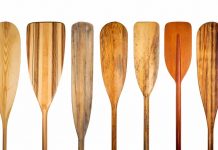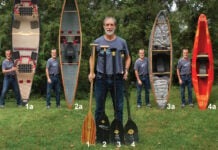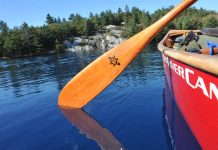Canoeists put a lot of time, consideration and money into deciding which boat will best carry them on their next adventures. Few put even a fraction of that energy into choosing a perfect paddle.
Your canoe paddle choice is important
Consider this. At 30 strokes a minute, I will paddle more than 1,800 strokes an hour, which can add up to around 14,400 strokes per day and more than 100,000 strokes per week. On an epic 21-day trip, I’ll paddle 302,400 strokes, give or take. I’ll never understand the people who agonize over the specs of a high-end canoe only to pair it with a Costco blade.
Your canoe paddle choice shouldn’t be an afterthought. Your canoe paddle choice will determine what kind of canoeing you pursue. The paddle is both a propeller and rudder—it’s our connection to the water and therefore one of the most important purchase decisions a paddler can make. But it’s not a simple one.
The chosen route—whether it’s simple lake paddling, navigating down bony rapids, or a combination of both—is a huge factor when choosing between the many blade styles.
Popular beaver and ottertail shapes are versatile and perfect for general use, like flatwater tripping and solo style paddling. Whitewater blades typically feature a much shallower and wider, square-tipped blade to enable a paddler to pull more water and deploy a stronger brace.
When routes feature both whitewater and flatwater, paddlers have to weigh the amount of time spent crossing flatwater and navigating boiling rapids to choose their primary blade.

Canoeists love bent shaft canoe paddles
A nine-to 14-degree bend in the shaft can improve stroke efficiency by about 10 percent by keeping the blade vertical in the water for longer. While bent shaft designs are more efficient, the design is not as effective for steering strokes. Most bent shaft paddlers switch sides at the call of “hutt” to keep the canoe straight instead of using J-strokes.
A canoe instructor I once paddled with is a faithful user of bent shaft paddles and, interested to see what all the fuss was about, I agreed to use one while on a trip together. Even though the instructor was right about our increased efficiency, I just couldn’t stand the style. It wasn’t for me. I’ve never cared much about going fast in the wilderness anyways. Every time he called out the command “hutt” I felt my eye twitch and, needless to say, we never paddled together again.
Modern canoeists don’t have to limit themselves to just the single blade
A double blade works perfectly to propel a kayak, and can also be used in a canoe, though some old-timers may snub their noses at you. And don’t forget the myriad of materials to consider—various woods, composites like aramid and carbon, plastics and more.
Natural materials typically have more flex, which is easier on joints for going long distances, but some space-age composite materials are so unbelievably featherlight they’re favored by marathon paddlers—confused yet?
There’s a lot to consider when selecting a canoe paddle
Don’t even get me started on palm grips and T-grips, or oval versus round shafts. Whichever type of paddling you prefer, the perfect tool is out there. A wood carver has a favored knife, a stone mason uses his chosen chisel, and a painter has a preferred brush.
The same goes for a canoeist’s paddle. When you find the right one, the act of moving across water feels like a painter creating a perfect watercolor on the surface of the lake.
“There’s magic in the feel of a paddle and the movement of a canoe, a magic compounded of distance, adventure, and solitude, and peace.” —Sigurd Olson. Feature Photo: Virginia Marshall









Excellent article! Best thing to do is to try out several different paddles and choose the one or two best suited to you and your style.
Yes to all but…fact is, a bent shaft paddle (in a length slightly longer than the canoeing literature recommends) actually works better for keeping a canoe on track (aka J-stroke, pitch stroke or solo-C stroke in the solo canoe) than does a straight paddle. Why? Because the bent blade runs closer to the keel-line–actually it runs slightly under the hull as the blade is turned, so less correction is needed. Most paddlers will raise their eyes at this. Why? Because the paddle they are using is just too short to work efficiently. I’m just 5’5″ tall and have ridiculously short arms–indeed when I was in the army, our supply sargeant laughed when the shortest shirts available was too inches too long for me. His exact comment was: “Hey lieutenant; I’ve never seen anyone with arms that short!” Still, I use a 54″ 12-degree bent paddle in my solo canoes and tandem canoes for all but rapids. I prefer a 57 or 58 straight blade for rapids. Try a longer bent-shaft than recommended and you’ll smile at the renewed control you’ll have of your canoe.
Agree Cliff, and in addition the bent shaft design is simply far more efficient. Sometimes when we’re training rookie paddlers they’ll say. “I’m a left (or right) side paddler”. Well not today is our reply. The pluses of the bent shaft design are as stated. The benefits of switching sides often are obvious. It allows the various muscles to recover and leads in general to a more balanced muscular structure. Switching (or any style paddling for that matter) works better with a light paddle. You may notice that all marathon canoe racers use bent shaft paddles and use the sit and switch paddling style, with as few control strokes as possible. This is true of any length race, from less than an hour to many days. That’s not only because of the speed advantage but also because marathon canoeing is all about efficiency. Use the paddle that you want, but understand what’s far more efficient.
Yes to bent shaft paddles! I am 76 and have exclusively used such paddles for the last 20 years for everything (solo and tandem) except heavy white water. Just the opposite of the “lieutenant” I have long skinny arms but, with damaged rotator cuffs (both shoulders) have actually shortened my paddle shafts by two inches so that my top hand is lower. I can still paddle a canoe for several hours a day for a week long trip with such a bent shaft, a 14 oz. lightweight with a carbon fiber shaft. The real lesson from all of this is to experiment constantly to find out what works best for your individual (and changing) circumstances.
As a teenager kneeling in the canoe and paddling with a single blade was just fine. As an older adult paddling from the padded tractor seat in the middle of the 14′ Clipper Packer, I find the double blade works exceeding well. The current blade has a carbon fiber shaft and a blade with the largest surface area I could find – great combination!!
That’s one of Jodie Lalonde’s Turtle Paddles. Nice stick.